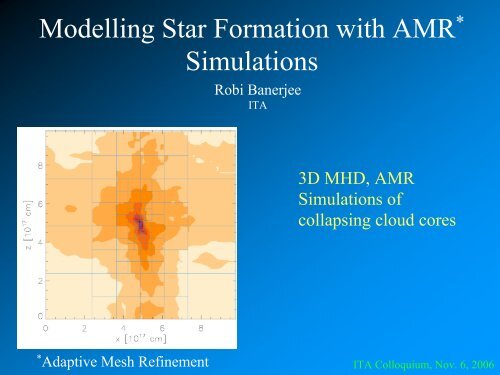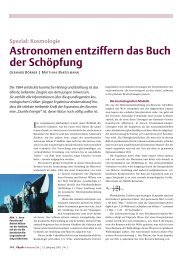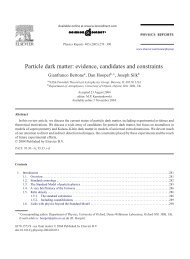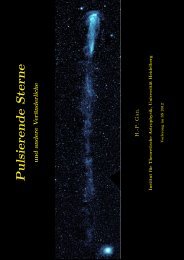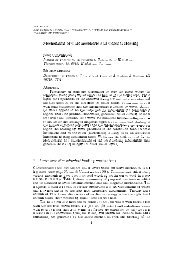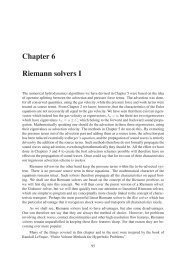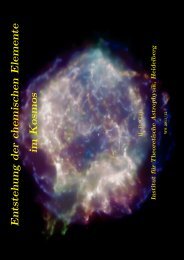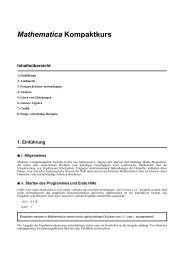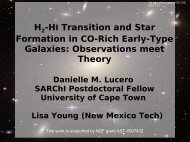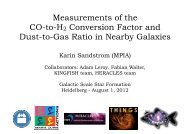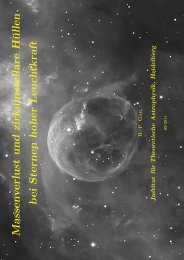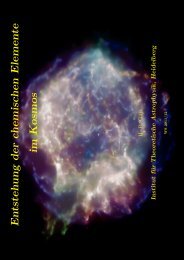Modelling Star Formation with AMR* Simulations
Modelling Star Formation with AMR* Simulations
Modelling Star Formation with AMR* Simulations
Create successful ePaper yourself
Turn your PDF publications into a flip-book with our unique Google optimized e-Paper software.
<strong>Modelling</strong> <strong>Star</strong> <strong>Formation</strong> <strong>with</strong> AMR *<br />
<strong>Simulations</strong><br />
Robi Banerjee<br />
ITA<br />
3D MHD, AMR<br />
<strong>Simulations</strong> of<br />
collapsing cloud cores<br />
* Adaptive Mesh Refinement ITA Colloquium, Nov. 6, 2006
<strong>Star</strong> <strong>Formation</strong> <strong>with</strong> AMR <strong>Simulations</strong><br />
Outlook<br />
Motivation / Introduction<br />
Numerical Method, AMR<br />
<strong>Modelling</strong> Cloud Cores<br />
Hydro Collapse <strong>Simulations</strong><br />
... <strong>with</strong> Magnetic Fields<br />
Outflows and Jets<br />
Turbulence<br />
Massive <strong>Star</strong>s<br />
Ongoing and Future Projects<br />
ITA Colloquium, Nov. 6, 2006
Present day <strong>Star</strong> <strong>Formation</strong> in (Giant)<br />
Molecular Clouds (GMCs)<br />
<strong>Star</strong>s form out of collapsing cloud<br />
cores<br />
Introduction<br />
<strong>Star</strong> <strong>Formation</strong> <strong>with</strong> AMR <strong>Simulations</strong><br />
Barnard 68,<br />
Cloud core (cold,<br />
self shielded)<br />
(Alves, Lada & Lada,<br />
Nature 2001)<br />
Orion Nebula (M 42), <strong>Star</strong> Forming region (HST image)<br />
ITA Colloquium, Nov. 6, 2006
<strong>Star</strong> <strong>Formation</strong> <strong>with</strong> AMR <strong>Simulations</strong><br />
Problems<br />
Motivation for numerical simulations<br />
Self Gravity: non-linear<br />
interactions<br />
Non-vanishing angular<br />
momenta ⇒ disk formation<br />
Chemical evolution, Cooling<br />
& Heating<br />
Magnetic Fields: Jets and<br />
Outflows?<br />
Radiation Feedback<br />
Horsehead Nebula (Barnard 33) in the OMC<br />
NOAO image<br />
Solution ⇒ Direct Numerical <strong>Simulations</strong><br />
ITA Colloquium, Nov. 6, 2006
<strong>Star</strong> <strong>Formation</strong> <strong>with</strong> AMR <strong>Simulations</strong><br />
Numerical Method<br />
FLASH* Code<br />
3D Grid based MHD integrator for<br />
parallel computing (MPI)<br />
Hydro solver: PPM, Kurganov<br />
MHD solver: MUSCL (van Leer) <strong>with</strong><br />
divB cleaning<br />
Gravity: multigrid or multipole, periodic or<br />
isolated BCs<br />
AMR: block structured (PARAMESH<br />
library);<br />
block resolutions vary by factors of two<br />
Refinement on own choice (e.g. gradient,<br />
curvature, density, etc.)<br />
IDL routines for visualization<br />
*Alliance Center for Astrophysical<br />
Thermonuclear Flashes (ASC),<br />
University of Chicago<br />
Current Version: 3.0<br />
Pros<br />
modular, easy to use<br />
large community: e.g. multi<br />
fluid nuclear reactions, RT<br />
module, N-body particles,<br />
cosmology<br />
support from developers<br />
Cons<br />
resource consuming<br />
not very fast<br />
block structured AMR (will<br />
be improved <strong>with</strong> newer<br />
versions)<br />
ITA Colloquium, Nov. 6, 2006
<strong>Star</strong> <strong>Formation</strong> <strong>with</strong> AMR <strong>Simulations</strong><br />
Numerical Method<br />
ITA Colloquium, Nov. 6, 2006
Applications<br />
Collapse of Hydrostatic Cores<br />
<strong>Star</strong> <strong>Formation</strong> <strong>with</strong> AMR <strong>Simulations</strong><br />
Bok Globule B 68<br />
Dust column density<br />
profile in terms of<br />
visual extinction<br />
follows a BE-Profile<br />
mass ~ 2.1 M sol<br />
Molecular Clouds in<br />
hydrostatic equilibrium<br />
follow a Bonnor-Ebert-<br />
Profile<br />
Critical BE Sphere:<br />
ξ = 6.451<br />
Other observational evidences:<br />
Coalsack globule 2,<br />
M ~ 4.5 M sol<br />
, (Racca, Gomez<br />
& Kenyon, 2002)<br />
Dark globule B335,<br />
M ~ 14 M sol<br />
,<br />
(Harvey et al. 2001)<br />
ITA Colloquium, Nov. 6, 2006
<strong>Star</strong> <strong>Formation</strong> <strong>with</strong> AMR <strong>Simulations</strong><br />
Collapse of Hydrostatic Cores<br />
Slowly rotating Bonnor-<br />
Ebert-Spheres<br />
Low Mass M ~ 2.1M sol<br />
High Mass ~ 170 M sol<br />
Cooling due to molecular<br />
excitations, gas-dust<br />
interaction, H 2<br />
dissociation<br />
AMR ⇒ resolves Jeans<br />
length <strong>with</strong> more than 8<br />
grid points during collapse<br />
(Truelove et al. 1997)<br />
Up to 27 refinement levels<br />
(dynamical range ~ 10 7 )<br />
Initial conditions:<br />
cool molecular cloud (T =<br />
16 K)<br />
hot ambient, low density,<br />
medium (pressure match at<br />
the sphere boundary)<br />
Ωt ff<br />
= 0.1 - 0.4<br />
BE-density profile<br />
ITA Colloquium, Nov. 6, 2006
<strong>Star</strong> <strong>Formation</strong> <strong>with</strong> AMR <strong>Simulations</strong><br />
Effect of molecular line cooling<br />
onset of non-isothermal<br />
collapse<br />
(T = 20 K)<br />
Temperature<br />
Main coolants: H 2<br />
O,<br />
CO, H 2 , O 2<br />
Efficient cooling in low<br />
density regime n~10 7.5<br />
(no dust)<br />
⇒ isothermal collapse<br />
Cooling sets a fixed<br />
physical length scale,<br />
r ~ c/(Gρ crit<br />
) 1/2 where<br />
t cool<br />
~ t ff<br />
⇒ warm core<br />
and shocked gas<br />
Cooling data from Neufeld & Kaufman, ApJ, 1993, and Neufeld, Lepp<br />
& Melnick, ApJS, 1995: radiative losses due to collisional excitations<br />
ITA Colloquium, Nov. 6, 2006
<strong>Star</strong> <strong>Formation</strong> <strong>with</strong> AMR <strong>Simulations</strong><br />
Cooling <strong>with</strong> Dust & H 2<br />
dissociation<br />
optical thick<br />
regime<br />
H 2<br />
dissociation<br />
Dust-gas interactions (Goldsmith<br />
2001) keeps the gas isothermal<br />
until n~10 11 cm -3 ⇒ scale of hot<br />
core: ~ few x 10 AU<br />
Optically thick at n ~10 11 cm -3<br />
⇒ heating <strong>with</strong> T ~ n 1/3<br />
H 2 dissociation at ~ 1200 K<br />
(Shapiro & Kang 1987)<br />
⇒ isothermal collapse (second<br />
collapse; Larson 1969)<br />
dissociation process is “selfregulating”<br />
due to strong<br />
temperature dependence<br />
ITA Colloquium, Nov. 6, 2006
<strong>Star</strong> <strong>Formation</strong> <strong>with</strong> AMR <strong>Simulations</strong><br />
Isothermal Bonnor-Ebert collapse<br />
∝R -2<br />
Time<br />
Time<br />
density<br />
Outside-in<br />
non-homologous collapse<br />
radial velociy<br />
ITA Colloquium, Nov. 6, 2006
Non-isothermal collapse phase<br />
Shock structures<br />
<strong>Star</strong> <strong>Formation</strong> <strong>with</strong> AMR <strong>Simulations</strong><br />
Temperature<br />
At least 2 shock fronts build<br />
up during the collapse <strong>with</strong><br />
Mach numbers ~ 2 - 4<br />
Temperature<br />
Note: only molecular line cooling<br />
no dust-gas interaction<br />
ITA Colloquium, Nov. 6, 2006
<strong>Star</strong> <strong>Formation</strong> <strong>with</strong> AMR <strong>Simulations</strong><br />
Disk <strong>Formation</strong> / Disk Structure<br />
Angular momentum<br />
conservation ⇒ formation of a<br />
disk<br />
Initial rotation determines disk<br />
size and structure (e.g. spiral<br />
arms, ring, binaries)<br />
Size of protodisk: few 100 AU –<br />
10 3 AU depending on initial<br />
spin<br />
BE case: Ωf ff<br />
= 0.1 ⇒ bar<br />
formation;<br />
Ωf ff<br />
= 0.2 ⇒ fragmentation<br />
(Matsumoto & Hanawa 2003, Banerjee et al.<br />
2004)<br />
Transport (redistribution) of<br />
angular momentum due to spiral<br />
arms and magnetic fields<br />
density<br />
ITA Colloquium, Nov. 6, 2006
<strong>Star</strong> <strong>Formation</strong> <strong>with</strong> AMR <strong>Simulations</strong><br />
Disk <strong>Formation</strong> / Disk Structure<br />
bar formation <strong>with</strong><br />
slow roation<br />
fragmention <strong>with</strong> faster initial rotation<br />
ITA Colloquium, Nov. 6, 2006
<strong>Star</strong> <strong>Formation</strong> <strong>with</strong> AMR <strong>Simulations</strong><br />
Disk structure<br />
Disk profile: Hayashi-type ∝R -3/2 (Hayashi, 1981)<br />
Shallow temperature profile ∝ R -1/4<br />
ITA Colloquium, Nov. 6, 2006
<strong>Star</strong> <strong>Formation</strong> <strong>with</strong> AMR <strong>Simulations</strong><br />
Magnetic Fields<br />
Jets / Outflow from YSOs<br />
magnetically driven?<br />
Ideally coupled to the gas (no<br />
ambipolar diffusion)<br />
Initially not dominant;<br />
P therm<br />
/P mag<br />
~ 80; B ~ μGauss<br />
ITA Colloquium, Nov. 6, 2006
<strong>Star</strong> <strong>Formation</strong> <strong>with</strong> AMR <strong>Simulations</strong><br />
Pre-collapse, Magnetic braking<br />
Linear regime: torsional<br />
Alfven wave is launched in the<br />
ambient medium (Poynting<br />
flux)<br />
Loss of initial angular<br />
momentum ⇒Magnetic<br />
braking (Mouschovias &<br />
Paleologou, 1980)<br />
Spin down time:<br />
In our case: ~ 10 6 years<br />
ITA Colloquium, Nov. 6, 2006
<strong>Star</strong> <strong>Formation</strong> <strong>with</strong> AMR <strong>Simulations</strong><br />
Large scale outflow<br />
Magnetic field is<br />
compressed <strong>with</strong> the gas<br />
Rotating disk generates<br />
toroidal magnetic field<br />
⇒ outflow (Blandford &<br />
Payne, 1982)<br />
Shock fronts are pushed<br />
outwards (magnetic tower;<br />
Lynden-Bell 2003)<br />
Outflow velocities<br />
v ~ 0.4 km/sec, M ~ 2-3<br />
Accretion: funneled along<br />
the rotation axis, through<br />
disk<br />
Banerjee & Pudritz 2006<br />
ITA Colloquium, Nov. 6, 2006
<strong>Star</strong> <strong>Formation</strong> <strong>with</strong> AMR <strong>Simulations</strong><br />
Large scale outflow<br />
Magnetic field is<br />
compressed <strong>with</strong> the gas<br />
Rotating disk generates<br />
toroidal magnetic field<br />
⇒ outflow (Blandford &<br />
Payne, 1982)<br />
Shock fronts are pushed<br />
outwards (magnetic tower;<br />
Lynden-Bell 2003)<br />
Outflow velocities<br />
v ~ 0.4 km/sec, M ~ 2-3<br />
Accretion: funneled along<br />
the rotation axis, through<br />
disk<br />
ITA Colloquium, Nov. 6, 2006
<strong>Star</strong> <strong>Formation</strong> <strong>with</strong> AMR <strong>Simulations</strong><br />
Jets from the inner disk<br />
Inner disk, collapse phase<br />
5 month later: a Jet is launched<br />
ITA Colloquium, Nov. 6, 2006
<strong>Star</strong> <strong>Formation</strong> <strong>with</strong> AMR <strong>Simulations</strong><br />
Jets from the inner disk<br />
Strongly pinched and<br />
warped field structure<br />
Jet velocities v ~ 3 km/sec<br />
Super-sonic (M ~ 4),<br />
Super-Alfvénic<br />
ITA Colloquium, Nov. 6, 2006
<strong>Star</strong> <strong>Formation</strong> <strong>with</strong> AMR <strong>Simulations</strong><br />
Magnetic field structure / evolution<br />
B z<br />
> B φ in the core and disk (expectation from a stationary<br />
accretion disk B ∝ R -1.25 ; Blandford & Payne 1982)<br />
B core<br />
∝ n 0.6<br />
Expected field strength in the protostar ~ 10 4 –10 5 G<br />
Potential seed field for Ap stars (Braithwaite & Spruit, 2004)<br />
ITA Colloquium, Nov. 6, 2006
<strong>Star</strong> <strong>Formation</strong> <strong>with</strong> AMR <strong>Simulations</strong><br />
Angular Momentum<br />
Banerjee & Pudritz in preparation<br />
ITA Colloquium, Nov. 6, 2006
<strong>Star</strong> <strong>Formation</strong> <strong>with</strong> AMR <strong>Simulations</strong><br />
Turbulence<br />
<strong>Star</strong> <strong>Formation</strong> takes place in a<br />
supersonic turbulent<br />
envrionment (e.g. Mac Low &<br />
Klessen 2004)<br />
Hydrostatic cores??? (but Shu<br />
et al. 1987, Mouschovias)<br />
ITA Colloquium, Nov. 6, 2006
<strong>Star</strong> <strong>Formation</strong> <strong>with</strong> AMR <strong>Simulations</strong><br />
Collapse <strong>with</strong> supersonic turbulence<br />
Initial data from Tilley & Pudritz<br />
2004: ZEUS simulations of core<br />
formation <strong>with</strong>in a supersonic<br />
turbulent environment<br />
L = 0.32 pc, M tot<br />
= 105 M sol<br />
Follow the collapse of the<br />
densest most massive region: ~<br />
23 M sol<br />
Final resolution: ~ R sol<br />
Initial setup as “seen” by the FLASH code<br />
ITA Colloquium, Nov. 6, 2006
<strong>Star</strong> <strong>Formation</strong> <strong>with</strong> AMR <strong>Simulations</strong><br />
Collapse <strong>with</strong> supersonic turbulence<br />
R.B., Pudritz & Anderson 2006<br />
Filament <strong>with</strong> an attached sheet<br />
small disk <strong>with</strong>in the filament (perpendicular)<br />
adiabatic (optically thick) core<br />
very efficient gas accretion through the filament<br />
ITA Colloquium, Nov. 6, 2006
<strong>Star</strong> <strong>Formation</strong> <strong>with</strong> AMR <strong>Simulations</strong><br />
Mass accretion<br />
Very high mass accretion rates: up to 10 v 3 in<br />
/G ~ 10 M 3 c 3 /G<br />
(cf. Shu '77 dM/dt ~ c 3 /G)<br />
Mass accretion rates are higher than limits from radiation<br />
pressure by burning massive stars (e.g. Wolfire & Cassinelli 1987:<br />
10 -3 M sol<br />
/year)<br />
Protostars and disks assemble very rapidly <strong>with</strong>in a<br />
supersonic turbulent environment<br />
ITA Colloquium, Nov. 6, 2006
<strong>Star</strong> <strong>Formation</strong> <strong>with</strong> AMR <strong>Simulations</strong><br />
Ongoing & Future Projects<br />
Feedback from Jets ⇒ Turbulence<br />
from Jet-clump interactions?<br />
Clump/Core formation by colliding<br />
flows (Vazques-Semandeni et al. 2006)<br />
Include Radiative Transfer<br />
(<strong>Formation</strong> of massive stars; Thomas<br />
Peters)<br />
Precessing Jets (<strong>with</strong> Christian Fendt)<br />
ITA Colloquium, Nov. 6, 2006
<strong>Star</strong> <strong>Formation</strong> <strong>with</strong> AMR <strong>Simulations</strong><br />
Summary<br />
Numerical simulations help to understand the star<br />
formation process<br />
Chemistry/Cooling important<br />
Magnetically driven outflows and jets from<br />
protstellar disk<br />
Magnetic fields reduce/prevent fragmentation<br />
Turbulence plays an important role (stucture of<br />
cloud cores, accretion rates)<br />
No stage of hydrostatic cores in a turbulent<br />
environment: assembly of protostars is a very rapid<br />
process<br />
ITA Colloquium, Nov. 6, 2006


